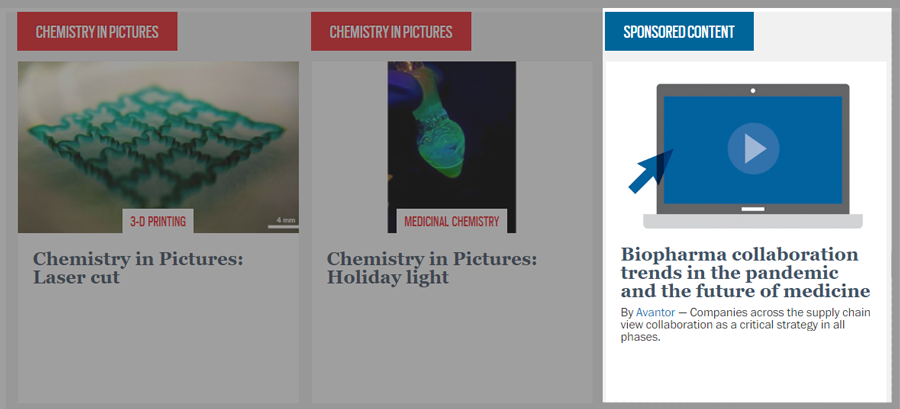Native science articles are great ways to reach targeted audiences, but their application can seem a bit tricky at first glance. Here we break down exactly what you need to know to write true native advertisements for scientific audiences. We address the purpose of native articles, how to write them for scientific audiences, and important considerations before getting started.
What is a Science Native Article?
Before we jump into answering questions about science native articles, let’s address a foundational question. What are native articles? Broadly, true native advertisements are paid advertisements that appear alongside content that is produced by a hosting page. Therefore, native articles share the same style, feel, and subject area as the content that lives on the hosting page. Native pieces are differentiated from organic content by the label ‘sponsored’ or ‘advertisement.’ And with nearly 65% of all digital display ads being native articles, it’s apparent that science companies are incorporating this kind of marketing more and more into their content strategies.

Now let’s discuss scientific native articles specifically. Just like all native articles, scientific native articles connect audiences with content that is interesting and valuable. However, what is interesting and valuable can vary greatly by scientific discipline. For example, molecular biologists may be interested in digital PCR quality control, as highlighted in a native advertisement placed in Nature Research by Bio-Rad. At the same time, genomic researchers may instead be interested in the single-cell analysis of human organoid models, which is content 10X Genomics placed in Cell Press. Finally, industrial chemists may be most curious about a rotovap automation webinar advertised in C&EN by Heidolph. Common themes throughout native scientific articles include the introduction of new technologies, highlighting relevant seminars, and presenting useful products.
Now let’s dive into the most common questions about science native articles!
1. What is the purpose of native articles in scientific space?
As highlighted above, science native articles connect scientists to content. Native articles instantly absorb the credibility of the hosting platform. For example, articles hosted on C&EN, Cell, Nature, or Science are automatically associated with the prestige of the publication. The powerful clout of scientific publishers is a great advantage for marketers trying to establish scientific credibility. Another native advertisement advantage is that content also bypasses issues experienced by other marketing delivery methods. Native articles aren’t blocked by AdBlock or mentally filtered out by consumers like banner ads. Scientists often filter out content delivered in the form of overt advertisements.
A critical native advertisement advantage is that customers prefer native advertisements as well. In fact, up to 70% of consumers report preferring native articles to traditional marketing. The data backs this up with consumers spending 53% more time looking at native ads. Creating native articles is a win-win scenario for both marketers and consumers.
Scientific communities are made of niche audiences, which can be challenging to target. Native articles are the perfect way to exist in spaces where scientists are. (Visit our previous post for more tips on reaching scientific audiences with native advertising.) For example, if your target audience is hematologists, it’s far easier to get in front of this audience with a targeted native advertisement in journals hematologists are reading, such as Blood (published by The American Society of Hematology).
2. How do you write successful native articles for scientific audiences?
First, your content must provide value. Scientists tend to be strapped for time and critical because of the nature of their field. Native articles should connect them with content they want to see— particularly content that aims to solve a unique problem. To do this well, it’s essential to thoroughly research your target audience. Learning about the researchers you want to connect with is always time well invested. As a great example of this research, let’s look at Signals Notebook. They are a company looking to break into the electronic notebook space and placed a native advertisement in C&EN. It’s clear for this advertisement that Signals Notebook took the time to understand the scientific audience before jumping in front of them. As such, they highlight how their product overcomes frustrations that scientists have historically experienced working with electronic notebooks— namely chemical structures, formulas, and collaboration.
Another critical place to thoroughly research is the platform you choose to host your article. Picking the right host site for your native article sets you up for a successful campaign. Additionally, it is essential to monitor and optimize your campaign. Record and review data on how well your pieces do and tweak your campaign as your understanding improves. If you are interested in learning about the latest techniques for creating native advertisements in the chemical sciences industry, see our article here.
3. When should you use native advertising?
The simple answer to this is ‘as often as you can’ because consumers prefer it. However, that may not always be practical. Instead, prioritize native article campaigns that meet these criteria:
The form and function of your content fits the platform
If your article is about antibody development, it could fit the form and function of The Journal of Immunology. If it’s about pipettes, a board journal would be a better fit. Whenever possible, try to target the most specific platform for your work to ensure high audience relatability.
The campaign requires instant credibility
Native articles are fantastic for launching new products. Established brands can produce content on their own platform. People know to google ‘10X Genomics’ for single-cell sequencing content, for example. But when a product is launched, it has no reputation. Therefore, appearing on a highly reputable website such as Cell or Nature adds an instant air of credibility.
Your target audience is on the platform
This again connects back to doing thorough research on your target audience. Science native advertisements work best on niche journals specific to your target scientific audience. For example, Nature Genetics for sequencing content and Materials for material science content.
The campaign is focused on building brand awareness
New brands can have a difficult time establishing a following. Paying for a native scientific advertisement slot in a scientific journal guarantees people will see your product.
4. What is content marketing vs. native advertising?
Content marketing vs. native advertising is a contentious topic. In broad strokes, content marketing focuses on ‘what’ the content is, while native advertising centers on ‘where’ the content is delivered. Content marketing focuses on producing quality content that builds consumer trust over time and gently leads them to action. Content marketing pieces can be distributed by various methods. Native advertising is a content distribution method where marketers pay to have their content inserted alongside a platform’s own. These ads are always disclosed with a notice such as ‘advertisement,’ ‘ad,’ or ‘sponsored content’ to ensure readers know they are reading promoted work. These strategies can work beautifully together to draw attention to content marketing pieces.
5. What are important considerations when writing native pieces for scientific audiences?
Credibility is vital in the scientific community. Without credibility, content is instantly dismissed. To avoid this, thoroughly complete your research before creating content for scientists; after all, it is their field of expertise. For example, this article in Nature about Cardiac PET imaging from Bracco is clearly an expert in the field. Along those lines, it’s essential to transparently label your content as an ad. Trying to pass true native advertisements as unpaid content is unethical and will likely backfire in scientific spaces. Above all your article must be helpful and wanted. To achieve this, you must invest time and effort into researching your target audience. One size does not fit all, and quality and relatability matter. To summarize:
- Be credible – ensure the content of your article is accurate
- Label the ad – be honest about advertisements
- Be helpful – solve specific problems experienced by the target audience
- Do your research – know your audience and choose the correct place to host your article


















